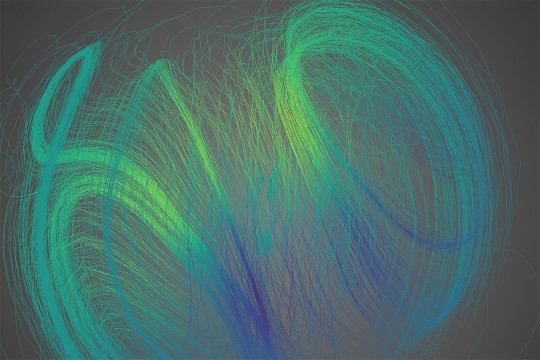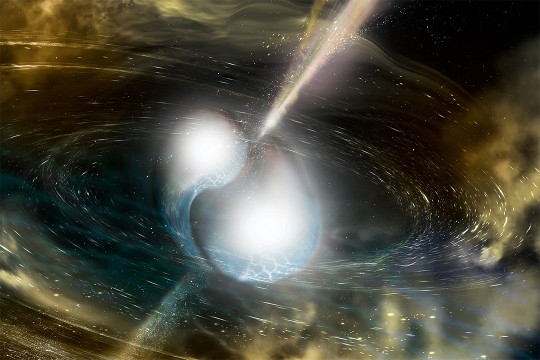News by Topic: Multimessenger Astronomy
-
January 15, 2021
![researcher posing on steps in the College of Science.]()
College of Science experiences boom in sponsored research
Several School of Physics and Astronomy faculty secured large grants as principal investigators during a banner summer.
-
December 16, 2020
![large ground satellite.]()
Scientists complete yearlong pulsar timing study after reviving long-dormant radio telescopes
While the scientific community grapples with the loss of the Arecibo radio telescope, astronomers who recently revived a long-dormant radio telescope array in Argentina hope it can help modestly compensate for the work Arecibo did in pulsar timing.
-
November 13, 2020
![graphic reads: Graduate Education Week, November 16-20.]()
RIT celebrates graduate student research with weeklong virtual symposium Nov. 16-20
RIT will celebrate graduate research during the 13th annual Graduate Education Week and Showcase: A Vision into the Future. The virtual event—Nov. 16 to 20—creates a platform for sharing and exchanging ideas during the COVID-19 pandemic, with pre-recorded and live presentations, demonstrations, visual exhibitions, and an alumni panel discussion.
-
November 5, 2020
![Color map of the curvature on the large black hole horizon generated by the near merging small black hole.]()
New black hole merger simulations could help power next-gen gravitational wave detectors
Scientists have developed new simulations of black holes with widely varying masses merging that could help power the next generation of gravitational wave detectors. RIT Professor Carlos Lousto and Research Associate James Healy from RIT’s School of Mathematical Sciences outline these record-breaking simulations in a new Physical Review Letters paper.
-
October 29, 2020
!['chart showing masses of blck holes in in the 50 gravitational wave events detected to date.']()
LIGO and Virgo announce 39 new gravitational wave discoveries during first half of third observing run
The LIGO Scientific Collaboration and Virgo Collaboration released a catalog of results from the first half of its third observing run (O3a), and scientists have detected more than three times as many gravitational waves than the first two runs combined. Several researchers from RIT’s Center for Computational Relativity and Gravitation were heavily involved in analyzing the gravitational waves and understanding their significance.
-
September 9, 2020
![artist's concept illustrating a hierarchical scheme for merging black holes.]()
RIT scientists contribute to the first discovery of an intermediate-mass black hole
The LIGO Scientific Collaboration and the Virgo Collaboration recently announced the discovery of GW190521, the most massive gravitational wave binary observed to date, and Rochester Institute of Technology scientists played an important role in identifying and analyzing the event.
-
April 22, 2020
![simulation of the magnetic field lines from a rotating neutron star.]()
NSF funds RIT researchers to develop code for astrophysics and gravitational wave calculations
The National Science Foundation recently awarded researchers at RIT, the University of Illinois at Urbana-Champaign, Louisiana State University, Georgia Tech and West Virginia University grants totaling more than $2.3 million to support further development of the Einstein Toolkit, a community-developed code for simulating the collisions of black holes and neutron stars, as well as supernovas and cosmology.
-
December 12, 2019
![large and small satellite dishes.]()
RIT and IAR observe pulsars for the first time from South America
A team from RIT and the Instituto Argentino de Radioastronomía (IAR) upgraded two radio telescopes in Argentina that lay dormant for 15 years in order to study pulsars, rapidly rotating neutron stars with intense magnetic fields that emit notably in radio wavelengths. The project is outlined in a new paper published in Astronomy and Astrophysics.
-
November 8, 2019
![Simulation of an accretion disk surrounding a supermassive black hole.]()
New study suggests ‘Pac-Man-like’ mergers could explain massive, spinning black holes
Scientists have reported detecting gravitational waves from 10 black hole mergers to date, but they are still trying to explain the origins of those mergers. The largest merger detected so far seems to have defied previous models because it has a higher spin and mass than the range thought possible. A group of researchers, including RIT Assistant Professor Richard O’Shaughnessy, has created simulations that could explain how the merger happened.
-
May 15, 2019
![Artist’s illustration of two merging neutron stars.]()
RIT to gather computational astrophysics experts from across the globe
Scientists conducting cutting-edge research in computational astrophysics will converge at RIT for two workshops in June. Experts from RIT, NASA Goddard Space Flight Center, Berkeley and other prestigious institutions will speak at the events hosted by RIT’s Center for Computational Relativity and Gravitation.
-
March 26, 2019
![Aerial view of space observatory.]()
RIT researchers set to help LIGO resume hunt for ripples in space and time
The Nobel Prize-winning project that hunts for gravitational waves— ripples in space and time—is about to begin the longest and most sensitive observational run to date. And several RIT researchers are preparing to pore over the new data to help uncover some of the universe’s biggest mysteries.





















